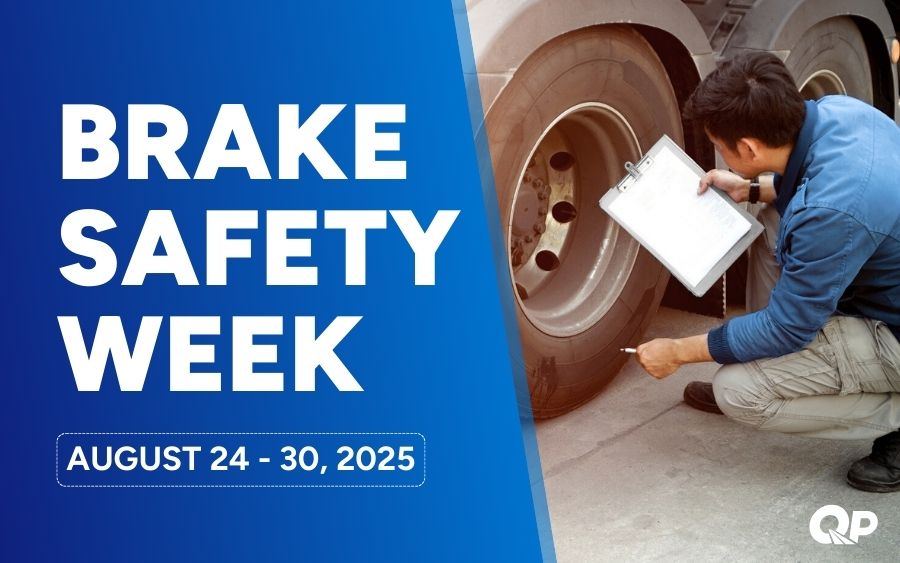Key Takeaways
- Dates: August 24 – 30, 2025.
- Focus Area: Brake drums and rotors.
- Action Step: Inspect, maintain, and document brake health
Brake Safety Week 2025 is scheduled for August 24-30. This annual event, organized by the Commercial Vehicle Safety Alliance (CVSA), focuses on inspecting and ensuring the safety of commercial vehicle braking systems. Inspectors will be looking for issues like worn brake linings, damaged drums and rotors, and improper brake adjustments.
What Is Brake Safety Week?
Brake Safety Week is a week-long enforcement initiative where CVSA-certified inspectors will conduct roadside inspections across North America, focusing on brake systems and components.
The program serves three critical purposes:
- Safety enforcement: Removing unsafe vehicles from roadways.
- Data collection: Gathering comprehensive brake violation statistics.
- Education: Teaching drivers and carriers about proper brake maintenance.
The goal is not to penalize drivers, but to proactively improve commercial motor vehicle brake safety and reduce crashes caused by faulty braking systems.
2025 Focus: Brake Drums & Rotors
This year, in addition to checking for brake-related out-of-service violations, inspectors will capture data on brake drum and rotor conditions. Here’s what they’ll be checking:
- Wear and Tear: Excessive wear reduces stopping power, making it harder to stop safely.
- Cracks or Damage: Damaged drums or rotors can fail under stress, posing serious risks.
- Debris Risks: Broken pieces from drums or rotors can dislodge, potentially causing accidents or injuries.
- Contamination: Oil, grease, or other contaminants on drums or rotors can compromise braking efficiency.
Vehicles with brake-related or other out-of-service violations will be removed from the road until repairs are made, so proactive maintenance is essential.
What to Expect During Brake Safety Week 2025
During August 24-30, 2025, expect:
- Increased Roadside Inspections: CVSA-certified inspectors in the U.S., Canada, and Mexico will conduct thorough checks, with a focus on brake systems.
- Inspection Levels: Most inspections will be Level IV (brake-focused inspections).
- Performance-Based Brake Testing (PBBT): Some jurisdictions will use PBBT to measure braking performance, submitting data to CVSA for analysis.
- Data Collection: Inspectors will document brake system conditions and violations, contributing to CVSA’s public report later in 2025.
How to Prepare for Brake Safety Week
Your best defense against an out-of-service violation is a proactive offense. Here’s a checklist to help you get ready:
- Conduct a Thorough Pre-Trip Inspection: Don’t just give your brakes a quick once-over. As part of your daily routine, pay special attention to the brake drums and rotors. Use a flashlight to check for cracks, wear, or contamination in hard-to-see areas.
- Listen and Feel for Warning Signs: Pay attention to your vehicle. Any grinding, squealing, or vibrations during braking could be a sign of worn-out pads or warped drums/rotors.
- Check Air Systems and Slack Adjusters: Make sure your air pressure is balanced and that your slack adjusters are properly calibrated. Excessive pushrod travel is a common violation. Some jurisdictions will even use Performance-Based Brake Testers (PBBTs) to measure your vehicle’s braking effectiveness.
- Stay on Top of Maintenance: Schedule a full brake system service well before the week of August 24-30. Make sure any needed repairs are made immediately and are consistent with the manufacturer’s guidelines.
- Keep Records Handy: Maintain a clear record of all maintenance and repairs. Having up-to-date documentation can streamline the inspection process.
Factoring in Brake Safety Costs
One of the biggest challenges trucking companies face is balancing immediate expenses with ongoing cash flow needs. Brake repairs and maintenance can’t wait, but sometimes the cash flow can be tight, especially when you’re waiting 30-90 days for customer payments.
Having access to consistent cash flow from services like freight factoring can make it easier to cover these essential, and sometimes unexpected, maintenance costs. Freight factoring gets trucking companies paid immediately for their completed deliveries. This immediate cash flow means you can cover brake repairs, maintenance services, and other expenses without disrupting operations.
The Bigger Picture: Why Brake Safety Week Matters
This annual event is about more than just passing an inspection. It’s about building a culture of safety. As a professional driver, your attention to detail and commitment to proper vehicle maintenance saves lives and keeps our roads safe. By taking the time to prepare, you’re not just avoiding a ticket—you’re doing your part to protect yourself, your cargo, and every other driver on the road.




